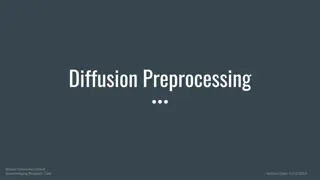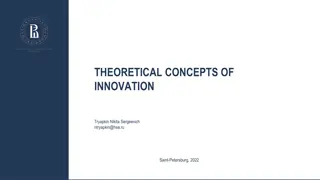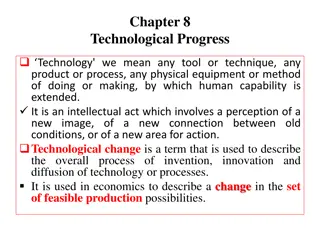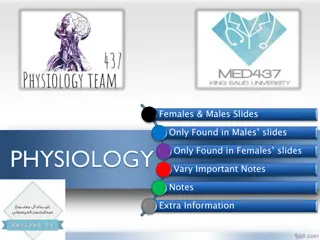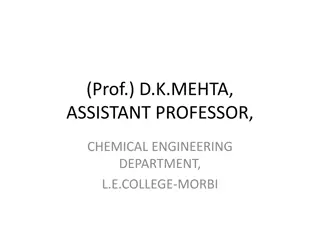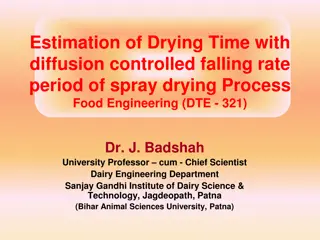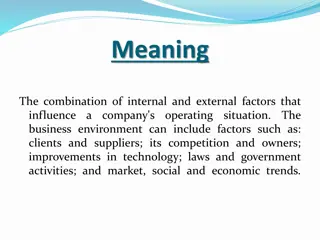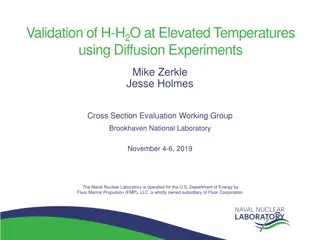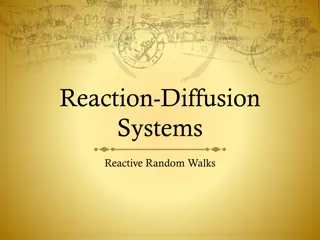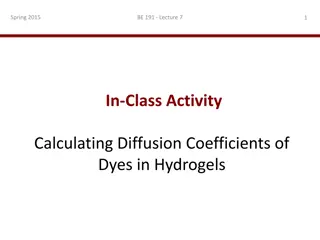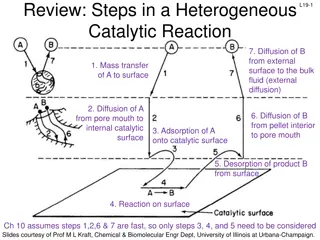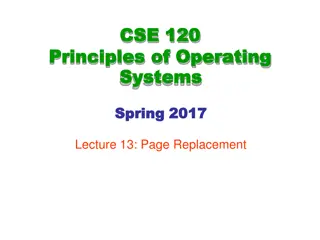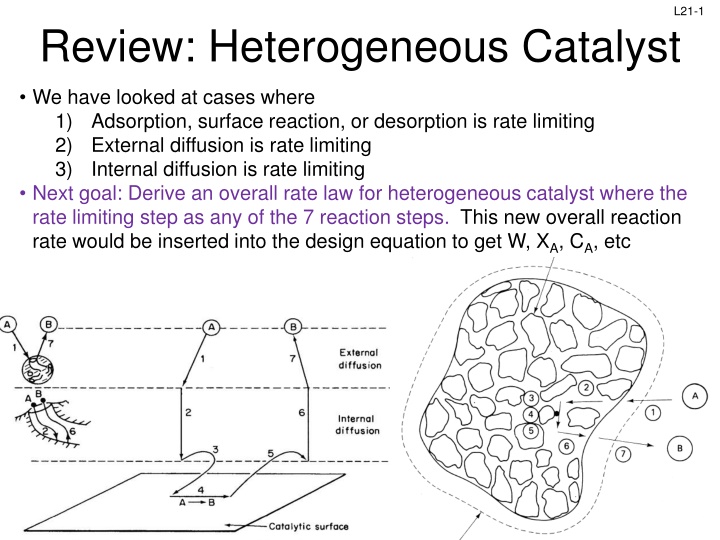
Deriving Overall Rate Law for Heterogeneous Catalyst Reactions
Explore the derivation of an overall rate law for heterogeneous catalysts, considering rate-limiting steps like adsorption, diffusion, and surface reactions. Learn how to incorporate this rate law into design equations for improved understanding of catalytic processes.
Download Presentation

Please find below an Image/Link to download the presentation.
The content on the website is provided AS IS for your information and personal use only. It may not be sold, licensed, or shared on other websites without obtaining consent from the author. If you encounter any issues during the download, it is possible that the publisher has removed the file from their server.
You are allowed to download the files provided on this website for personal or commercial use, subject to the condition that they are used lawfully. All files are the property of their respective owners.
The content on the website is provided AS IS for your information and personal use only. It may not be sold, licensed, or shared on other websites without obtaining consent from the author.
E N D
Presentation Transcript
L21-1 Review: Heterogeneous Catalyst We have looked at cases where 1) Adsorption, surface reaction, or desorption is rate limiting 2) External diffusion is rate limiting 3) Internal diffusion is rate limiting Next goal: Derive an overall rate law for heterogeneous catalyst where the rate limiting step as any of the 7 reaction steps. This new overall reaction rate would be inserted into the design equation to get W, XA, CA, etc Slides courtesy of Prof M L Kraft, Chemical & Biomolecular Engr Dept, University of Illinois at Urbana-Champaign.
L21-2 Review: Internal Diffusion Effects in Spherical Catalyst Particles Internal diffusion: diffusion of reactants or products from particle surface (pore mouth) to pellet interior Concentration at the pore mouth will be higher than that inside the pore Step 1) Mole balance over the shell thickness r is: IN - OUT + GEN = ACCUM Internal diffusion ( ) 2 2 2 A 4 r 4 r + 4 r = W W r r 0 CAb Ar r Ar r r m c CAs R Volume of shell External diffusion r r A: rxn rate per mass of catalyst c: catalyst density rm: mean radius between r and r - r ) 2 A c r r 0 = spherical catalyst particle ( 2 d W r Differential BMB in Divide by - r & take limit as r 0 Ar dr Slides courtesy of Prof M L Kraft, Chemical & Biomolecular Engr Dept, University of Illinois at Urbana-Champaign.
Review: Diffusion & Rxn in Spherical Catalyst ( Ar r d L21-3 CAs ) 2 d W r 2 A = r r 0 (step 1, BMB ) c R r r+ r System at steady state, so EMCD: WB = -WA (otherwise A or B would accumulate) dy dr dC dr A A = cD = D W A e e Rate law: = mol m mol g cat s catalyst surface area mass of catalyst n = = r'' k C -r ' r'' S S A n A A A A A 2 s dC dr d dr + Solve for CA(r) & get WAr(r) from diffusion eq Insert diffusion eq & rate eq into BMB: 2 2 n A = D r r S A n k "C 0 e C A Slides courtesy of Prof M L Kraft, Chemical & Biomolecular Engr Dept, University of Illinois at Urbana-Champaign.
L21-4 Review:Dimensionless Variables + dr dr C C R ( e A s D C 2 2 n n 2 d d Thiele modulus for rxn of nthorder n Subscript n = reaction order n is small: surface reaction is rate limiting n is large: internal diffusion is rate limiting C sinh 1 C sinh a 1st order rxn: small 1: surface rxn control, significant amount of reactant diffuses into pellet interior w/out reacting large 1: surface rxn is rapid, reactant is consumed very closed to the external surface of pellet (A waste of precious metal inside of pellet) dC d 2 2 n A Put into dimensionless form = D r r S k" C 0 e C A n A n 2 n 1 s k" S R C 0 k" S R C r A 2 2 n a c As n a c A = = = = n n ) R D As e Boundary Conditions: =1 at =1 d 2 d + = 0 =finite at =0 "a" surface rxn rate "a" diffusion rate 2 = n small 1 C C A The solution for A 1 = = medium 1 As As 1 large 1 R r=0 Slides courtesy of Prof M L Kraft, Chemical & Biomolecular Engr Dept, University of Illinois at Urbana-Champaign.
L21-5 Review: Internal Effectiveness Factor, ( ) actual observed overallrate of rxn rate of reactionif entire interior surface were exposed to C = eta & T As s ( ) r' r' mass of catalyst mass of catalyst r r'' r'' A A A = = = ( ) As r As As Effectiveness factor vs n n 1 2 k R S C 1 2 n a c D As = n 0.8 0.6 Reaction limited e As particle diameter , n , 1, rxn is surface rxn limited 0.4 0.2 As particle diameter , n , 0, rxn is diffusion limited Internal diffusion limited 0.1 0.2 1 2 4 6 8 10 1 Slides courtesy of Prof M L Kraft, Chemical & Biomolecular Engr Dept, University of Illinois at Urbana-Champaign.
L21-6 Review: Effectiveness Factor & Rxn Rate c 1 a k S D 3 ( ) ( ) ( ) = R = = r As r 1 As k C S = coth 1 1 A a 1 1 2 1 e R 1 surface-reaction-limited 1 D 3 3 R k e can be simplified to: = when ,( 30) , 1 1 S 1 1 c a 1 is large, diffusion-limited reaction inside the pellet (external diffusion will have a negligible effect on the overall rxn rate because internal diffusion limits the rxn rate) 3 cot r D 3 R k S r D 3 R k ( ) A e S = = h 1 When internal-diffusion-limited: 1 1 2 1 As 1 c a D e a S k 3 ( ) 1 e A = = -r C r 1 As C k S ( ) = r 1 As k C S As A a R A a c 1 c a Overall rate for 1st-order rxn To increase the overall rate of a rxn limited by internal diffusion (1) decrease the radius R (3) increase the concentration of A (2) increase the temperature (4) increase the internal surface area Slides courtesy of Prof M L Kraft, Chemical & Biomolecular Engr Dept, University of Illinois at Urbana-Champaign.
L21-7 L21: Simultaneous Internal Diffusion & External Diffusion Goal: Derive a new rate eq that accounts for internal & external diffusion -r A is a function of reactant concentration Reactant conc is affected by internal & external diffusion Express reactant conc in terms of diffusion-related constants & variables Use mole balance At steady-state: transport of reactants from bulk fluid to external catalyst surface is equal to net rate of reactant consumption in/on the pellet CAs CAb Molar rate of mass transfer from bulk fluid to external surface: M C(r) ( ) = W a V A Ar c reactor volume molar flux external surface area per unit reactor volume This molar rate of mass transfer to surface is equal to net rxn rate on & in pellet! ( A A M r external area ) = + internal area Slides courtesy of Prof M L Kraft, Chemical & Biomolecular Engr Dept, University of Illinois at Urbana-Champaign.
L21-8 Basic Molar Balance at Pellet Surface Flux: bulk to external surface ( Ar W ac: external surface area per reactor volume (m2/m3) V: reactor volume (m3) -r A: rate of reaction per unit surface area (mol/m2 s) Sa: surface area of catalyst per unit mass of catalyst (m2/g cat) b: bulk density, catalyst mass/ reactor volume b= c(1- ) : porosity of bed (void fraction) c: catalyst density M W a V = M W a = Typically external surface area <<< internal surface area M W = Actual rxn rate per unit total S.A. External S.A. external + internal S.A. x = x ( ) ( ) ) r a a V = + V S V c A c a b r R = ( ) = = + ) r a V a b S S V A Ar c A c ( r R = = + r a A Ar c A c a b r R r S = = a A Ar c A a b r R Slides courtesy of Prof M L Kraft, Chemical & Biomolecular Engr Dept, University of Illinois at Urbana-Champaign.
L21-9 Overall Molar Rate of Reaction Overall rxn rate = flux to surface = rxn rate on & in pellet = = W M W a r S A Arr c A a b = R ( ) = k C C For external mass transport: Ar c Ab As r R = Since internal diffusion resistance is also significant, the reactant conc at the internal surface is lower that the reactant conc at the external surface: r'' r ' ( ) A = = r'' r'' For a 1st order rxn: -r A=- k1CAs As A ' As ( ) actua reint l observed o erior surfa verallrate of rxn were expo ce where the internal effectiveness factor: = rxn rateif enti sed to C & T As s Plug flux & 1st order rxn rate back into the mass balance: ( ) c Ab A c As M a k C k C k C a k C a k C S = = = 1 As C a b S Solve mass balance for CAs k C a k C = k C k S + 1 As a b S a k a + k C As c a c Ab c c As c 1 As a b c Ab c c ( ) c Ab c = = + C k C a C 1 a b k S c c k a As c Ab c As 1 a b c c Slides courtesy of Prof M L Kraft, Chemical & Biomolecular Engr Dept, University of Illinois at Urbana-Champaign.
L21-10 Overall Effectiveness Factors c c k a C + Ab = C Finally insert CAs into r A As c c k a 1 a b k S 1 c c k k a C k a + Overall rxn rate with internal & external diffusion Ab = = r 1 As k C r A A 1 a b k S c c Is this the overall rxn rate that we ALWAYS use for a surface reaction that has internal & external? (a) Yes, we should always use this rate equation for a surface reaction (b) No, we should only use this rate eq for processes that use spherical catalyst pellets (c) No, we should only use this rate eq for processes that that involve catalyst particles that have a constant density & even catalyst loading on the surface (d) No, we should only use this rate eq for 1st order irreversible reactions (e) b, c, & d Slides courtesy of Prof M L Kraft, Chemical & Biomolecular Engr Dept, University of Illinois at Urbana-Champaign.
L21-11 Overall Effectiveness Factors c c k a C + Ab = C Finally insert CAs into r A As c c k a 1 a b k S 1 c c k a C k a Overall rxn rate with internal & external diffusion Ab A A = = r 1 A k C r s + k 1 a b k S c c Remember, the internal effectiveness factor (based on CAs) is: actualoverallrate of reaction rate of rxnif entire interior surface were exposed to the external surface conditions = The overall effectiveness factor (based on CAb) is defined as: actualoverallrate of reaction rate of reactionif entire interior surface were exposed to the bulk conditions k C 1 k S k C ( ) Ab A r r'' Put into design eq to account for internal & external diffusion Omega = A r r 1 Ab A Ab = = + k c c a r Ab r 1 a b = = + 1 1 a b k S c c k a 1 Ab = Slides courtesy of Prof M L Kraft, Chemical & Biomolecular Engr Dept, University of Illinois at Urbana-Champaign.
L21-12 Rxn Rate Variation vs Reactor Conditions D r' k Sh d 1 2 13 Ud D p AB AB d = = + k 2 0.6 External diffusion A c c D p p AB c 1 a k S D c 1 a k S D 3 = r k C As a S = R coth R 1 Internal diffusion A r c 1 a k S D 2 e e R e Surface reaction -r A=kCA Variation of Reaction Rate with: Superficial velocity Type of Limitation Particle size Temperature U1/2 dp-3/2 Linear External Independent dp-1 Exponential Internal Independent Independent Exponential Surface reaction Slides courtesy of Prof M L Kraft, Chemical & Biomolecular Engr Dept, University of Illinois at Urbana-Champaign.
L21-13 Consider an isothermal catalytic reaction in a PBR where there is no pressure drop and the catalyst pellets are uniformly packed & spherical. The kinetics are 1st order, and k, all physical parameters, and the inlet conditions (pure A in feed, A products) are given. Derive an equation for XA, taking into account the diffusion to and within each catalyst particle, but ignore diffusion down the length of the reactor. dX F r' dW Rate must account for diffusion & be in terms of catalyst surface area A = PBR design eq: A0 A = -r' r'' S ( 1. Put rate in terms of the unit surface area: A A a ) r = = -r' r'' S r'' 2. Account for diffusion limitations in rate eq: A Ab a A Ab = = -r' kC S r'' kC 3. Rate is 1st order: A Ab a Ab Ab dX dW C A = F kC S 4. Put into design eq: A0 Ab a dX dW ( ) ( ) A k S C = 1 X F 5. Put Cab in terms of XA: = 1 X C A0 a Ab0 A Ab Ab0 A ( ) X W k S C 1 X k S C F dX 1 X A dX dW 6. Integrate: a Ab0 F A a Ab0 A A = = dW ( ) A0 A A0 0 0 Slides courtesy of Prof M L Kraft, Chemical & Biomolecular Engr Dept, University of Illinois at Urbana-Champaign.
L21-14 Consider an isothermal catalytic reaction in a PBR where there is no pressure drop and the catalyst pellets are uniformly packed & spherical. The kinetics are 1st order, and k, all physical parameters, and the inlet conditions (pure A in feed, A products) are given. Derive an equation for XA, taking into account the diffusion to and within each catalyst particle, but ignore diffusion down the length of the reactor. X W k S C W k S C F dX 1 X A ( ) a F Ab0 a Ab0 A = = ln 1 X 6. Integrate: dW A ( ) A0 A A0 0 0 k S C k S C W W a Ab0 FA0 ( ) a Ab0 = ln 1 X 7. Solve for XA: A = F 1 X e A0 A k S C W k S W a Ab0 FA0 a 0 1 e = 1 e = X X A A Slides courtesy of Prof M L Kraft, Chemical & Biomolecular Engr Dept, University of Illinois at Urbana-Champaign.
L21-15 XA for 1st order rxn executed in an isothermal PBR packed with spherical catalyst particles with internal & external diffusion limitations k Sa W 0 1 e = X A For same conditions, eq derived in Fogler (12-71) for XA at end of reactor of length L is: k Sa L b U 1 e = kg = m X A catalyst mass reactor volume 0 = where: L= z U=superficial velocity= b 3 A c Are these equations the same? k S k S W L a a b U ? They differ in the exponent: 0 ( ) L ( ) L A W? W? W V V ( ) L A W? W W V W? = V b 0 b c b = c 0 0 0 0 0 0 0 0 0 A k S W c a k S L a b U 0 1 e = 1 e = = X X A A Slides courtesy of Prof M L Kraft, Chemical & Biomolecular Engr Dept, University of Illinois at Urbana-Champaign.

